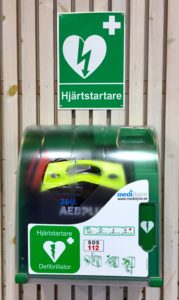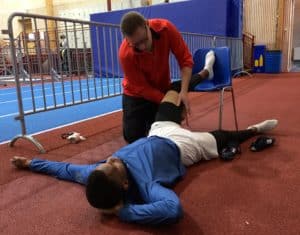Emergency care
Treatment of acute (sudden) injuries and other conditions.
In athletics, the two most common injuries requiring acute care are ankle sprains (twisting the ankle) and hamstring strains (muscle pull). For these types of injury, it is important to act quickly in order to minimize consequences such as bleeding and swelling in the injured area. Providing care quickly means that injury rehabilitation starts earlier and that the injured athlete can return to training sooner.
A pressure should preferably be applied within 30 seconds and is recommended to be applied for approximately 30 minutes. If the pressure starts to cause pain (not unusual after about 10-15 minutes), the pressure eases slightly. After about 30 minutes, the acute bleeding has decreased and the pressure bandage can then be replaced with a compression bandage.
Acute treatment of sports injuries follows the PRICE guidance, PRICE stands for:
Protect – Protect the injured area so that any damage is not made worse
Rest – rest to minimize blood circulation and continued bleeding
Ice – cold for pain relief (An ice bag can also provide pressure!)
Compression – Apply pressure to stop the bleeding! For example, by using a bandage or gauze. This is the most important thing to do straight away!
Elevate – Raise the injured body part (if possible) to reduce bleeding.
To lessen the risk of exacerbating the injury the load applied to the injured area should be reduced, for example by using crutches, and pressure should be applied for 48-72 hours post injury.
In recent years POLICE has begun to be used as an update of PRICE. POLICE is used to emphasise the importance of beginning gentle activity soon after injury.
Protection – protection, as described above.
Optimal loading – after a few days of rest you can, in agreement with a treating therapist, start performing some light exercises for mobility and muscle activation etc.
Ice – cold for pain relief.
Compression – Apply pressure to stop bleeding.
Elevation – Raise the injured body part.
How should we deal with an acute athletics injury?
Watch this video for advice on acute care of hamstring strains (in Swedish):
Concussion, which can occur from a blow to the head, is a relatively unusual injury in athletics. If concussion is suspected then medical services should be contacted.
Accidents
First Aid can mean anything from handling minor wounds to providing care while waiting for healthcare personnel to arrive, e.g. an ambulance. Any First Aid provided should be prioritised according to L-ABC;

Life-threatening location – Move the person if they are in danger, for example in the case of fire.
Breathing – check the person’s breathing, airways and pulse. If the person’s breathing is stable, place them in the recovery position. If not, start cardiopulmonary resuscitation (CPR).
Bleeding – Stop any major bleeding
Circulation Failure / Shock – If a person has lost a lot of blood then they are at risk of circulatory failure. Place the person in the recovery position with their knees bent up.
Cardiopulmonary resuscitation (CPR) – is a First Aid treatment given to a person who has had a cardiac arrest, with the aim of maintaining heart and lung function.
In the event of an accident and/or questions call the Swedish Health Care Information 1177.
In the case of emergency call 112.
Tip!
Find out where the First Aid bag and Defibrillator are kept at your sports facility!
References and further reading:
Peterson L, Renström P. Sports Injuries. 4ed. Taylor and Francis. 2016.
Thomeé R, Swärd L, Karlsson J. Nya Motions- och idrottsskador och deras rehabilitering. SISU Idrottsböcker. 2011.
Certified physiotherapist. Medical coordinator Swedish Athletics. Associate Professor in Public Health/Health in Sport, with a primary research focus on health in sport.



